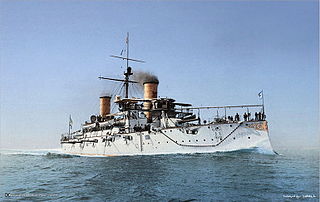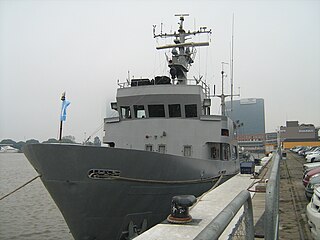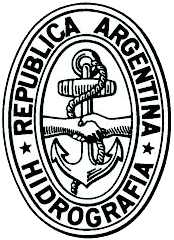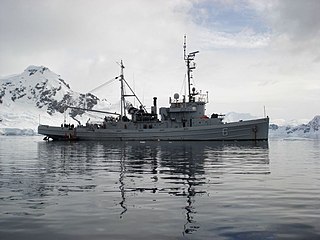
ARAGeneral Belgrano (C-4) was an Argentine Navy light cruiser in service from 1951 until 1982. Originally commissioned by the U.S. Navy as USS Phoenix, she saw action in the Pacific theatre of World War II before being sold to Argentina. The vessel was the second to have been named after the Argentine founding father Manuel Belgrano (1770–1820). The first vessel was a 7,069-ton armoured cruiser completed in 1896.

ARA Almirante Irízar is a large icebreaker of the Argentine Navy. She was ordered from a shipyard in Finland in 1975.

ARA Almirante Domecq Garcia (D23) was a Fletcher-class destroyer which served with the Argentine Navy from 1971 to 1983.

ARA Patagonia (B-1) is a multi-product replenishment oiler of the Durance class in service in the Argentine Navy. She was the lead ship of her class serving in the French Navy as Durance from 1977 to 1999. In French service, the ship served with the Force d'action navale. In Argentine service the vessel is used in multi-national naval exercises and supplies the Antarctic missions operating from Ushuaia. In 2017, Patagonia was used to search for the missing submarine ARA San Juan.

ARA Sarandí is the fourth and last ship of the MEKO 360H2 series of destroyers built for the Argentine Navy. The ship is also the fourth ship in the Argentine Navy to bear that name. Sarandí is the name of a victory of the Argentine army during the Cisplatine War.

ARA Espora (P-41) is the lead ship of the MEKO 140A16 Espora class of six corvettes built for the Argentine Navy. Commissioned in 1985, she is used for fishery patrol. She is homeported at Puerto Belgrano Naval Base and is part of the Navy's 2nd Corvette Division with her five sister ships. The ship is the sixth ship to bear the name of Colonel (Navy) Tomás Espora, who fought in the Argentine Navy during the Cisplatine War. Generator failure left her stranded in South Africa for 73 days in late 2012.

ARA Rosales (P-42) is the second ship of the MEKO 140A16 Espora class of six corvettes built for the Argentine Navy. The ship is the fourth ship to bear the name of Colonel (Navy) Leonardo Rosales, who fought in the Argentine Navy during Argentina's war of independence and the Cisplatine War.

USS Cahuilla (ATF-152) was an Abnaki class fleet tug in the service of the United States Navy during World War II. In 1961 she was sold to the Argentine Navy as ARA Irigoyen (A-1) where she served until 2009 when she became a Museum ship.

The RV Sonne was a former German fishing trawler converted into a research vessel by Schichau Unterweser AG, doing mostly geoscience-related work for a variety of commercial and scientific clients. She was registered in Bremen. In 2015 she was sold to the Argentine institute CONICET and was renamed ARA Austral (Q-21). A new geoscientific research ship, also called RV Sonne, replaced her role in Germany that same year.

The Rio Santiago Shipyard is a shipyard located in the city of Ensenada, Buenos Aires Province at the shores of the Santiago River. Currently owned by the Government of Buenos Aires Province, it has been one of the major active and important shipyards in Latin America. Founded in 1953, it has realized diverse functions in the naval, industrial and railroad sectors. In its golden age the shipyard reached 8,000 workers on double shift. In 2008 relies on 2,700 workers.

ARA General Belgrano was a Giuseppe Garibaldi-class armoured cruiser of the Argentine Navy. The ship was built in Italy, along with three sister ships also for Argentina. The vessel was the first to have been named after the Argentine founding father Manuel Belgrano (1770–1820). The ship was laid down in 1896 and served on the Argentine Navy until she was stricken on 8 May 1947.

ARA Comodoro Somellera (A-10) was a Sotoyomo-class rescue tug that served in the Argentine Navy from 1972 to 1998 classified as an aviso. She previously served in the US Navy as USS Catawba (ATA-210) from 1945 to 1972. After being damaged beyond repair in 1998, she was sunk on purpose as a weapons target in November 2017.

ARA Comodoro Rivadavia (Q-11) is a survey ship of the Argentine Navy assigned to the national Hydrographic Naval Service which among other things is responsible of the maintenance of nautical charts, balises and lighthouses.

The Argentine Hydrographic Service is the branch of the Ministry of Defense responsible for providing hydrographic services.

ARA Suboficial Castillo (A-6) was an Abnaki-class tug/patrol boat of the Argentine Navy. She previously served in the United States Navy as USS Takelma (ATF-113) from 1944 to 1992. The ship was acquired by Argentina in 1993 and was in service until the 2020s. In 2022, the ship was put up for sale. Suboficial Castillo was used as support ship for both the Argentine Submarine Force and during the summer campaigns in Antarctica in the Patrulla Antártica Naval Combinada with the Chilean Navy to guarantee safety to all touristic and scientific ships that are in transit within the Antarctic Peninsula.

ARA Alférez Sobral (A-9) is an 800-ton ocean-going tug that was in service with the Argentine Navy from 1972 until 2019, where she was classified as an aviso. She had previously served in the US Navy as the fleet tug USS Salish (ATA-187). In Argentine service an aviso is a small naval vessel used for a number of auxiliary tasks, including tugging, laying buoys, and replenishing other ships, lighthouses and naval bases.
ARA Ingeniero Julio Krause (B-13) was an oil tanker ship in service with the Argentine Navy from 1993 to 2015, and with YPF from to 1981 to 1993. She was the first ship in the Argentine Navy to bear the name of Argentine engineer Julio Krause, who discovered oil in Comodoro Rivadavia in 1907.

ARA Punta Alta (Q-63) is a multipurpose auxiliary ship of the Argentine Navy, built in the Curtis Bay Shipyard, United States, in 1964; transferred to Argentina in 2000, she is based at Puerto Belgrano. The vessel is named after the Argentine city of Punta Alta, which is close to Puerto Belgrano, and is the second Argentine naval ship with this name.
ARA Punta Médanos (B-18) was an auxiliary ship of the Argentine Navy, a tanker built at the Swan, Hunter & Wigham Richardson shipyard, Wallsend, in 1950. While in naval service she made several commercial trips supplementing the YPF tanker fleet, and supported the high seas fleet; in this capacity Punta Médanos participated in the Falklands War in 1982. She was decommissioned in 1984 and sold for scrapping. The vessel was named after the coastal feature of Punta Médanos, Argentina, and was the first Argentine naval ship with this name.


















